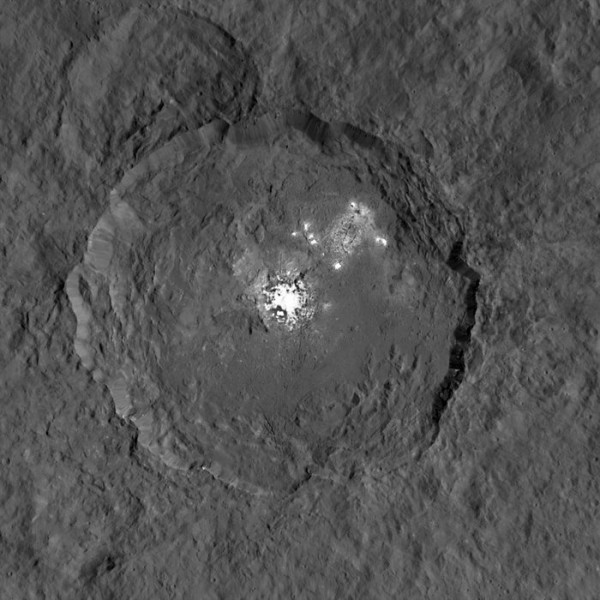
Astronomers have seen unexpected changes in the dwarf planet Ceres’ famous bright spots. The most prominent of the Ceres bright spots lie inside the crater Occator, but there are many bright spots on this little world. One group of astronomers said in December they are likely salt deposits. The spots appeared eye-catchingly strange to the cameras of the Dawn spacecraft when it began orbiting Ceres in March, 2015. Now astronomers on Earth have found ingenious ways to study the bright spots, too, and new work suggests that the spots brighten during the day and also show other variations. These observations suggest that the material of the spots is volatile and evaporates in the warm glow of sunlight.
The work suggests that Ceres may be a much more active world than most of its asteroid neighbors. The new study’s lead author, astronomer Paolo Molaro, said:
As soon as the Dawn spacecraft revealed the mysterious bright spots on the surface of Ceres, I immediately thought of the possible measurable effects from Earth. As Ceres rotates the spots approach the Earth and then recede again, which affects the spectrum of the reflected sunlight arriving at Earth.

NASA/JPL-Caltech/UCLA/MPS/DLR/IDA
In the words, as Ceres spins on its axis every nine hours, the velocities of the dwarf planet’s bright spots towards and away from the Earth change slightly. This minute change in velocity would be exceedingly small, on the order of 12 miles (20 km) per hour. But, according to these astronomers, this motion is big enough to be measurable via the Doppler effect with high-precision instruments such as the HARPS spectrograph at the ESO 3.6-metre telescope at La Silla, Chile.
The team observed Ceres with HARPS for over two nights in July and August 2015. A study co-author, Antonino Lanza, said:
The result was a surprise.
We did find the expected changes to the spectrum from the rotation of Ceres, but with considerable other variations from night to night.
The team concluded that the observed changes could be due to the presence of volatile substances that evaporate due to the sun’s radiation. That result would be consistent with the idea that the bright spots are made of hydrated magnesium sulphates (salt) or even freshly exposed water ice. According to the astronomers’ statement, if this evaporation is indeed taking place:
… when the spots inside the Occator crater are on the side illuminated by the sun they form plumes that reflect sunlight very effectively. These plumes then evaporate quickly, lose reflectivity and produce the observed changes. This effect, however, changes from night to night, giving rise to additional random patterns, on both short and longer timescales.
If this interpretation is confirmed Ceres would seem to be very different from Vesta and the other main belt asteroids. Despite being relatively isolated, it seems to be internally active.
Ceres is known to be rich in water, but it is unclear whether this is related to the bright spots. The energy source that drives this continual leakage of material from the surface is also unknown.
It makes sense, by the way, that Ceres would be different from its neighboring asteroids. It’s the largest body in the asteroid belt between Mars and Jupiter. Formerly known as the first asteroid ever to be discovered, it’s now considered the only object in the asteroid belt – indeed in the entire inner solar system – worthy of being classified as a dwarf planet.
The artist’s impression video above is based on a detailed map of the surface compiled from images taken from NASA’s Dawn spacecraft in orbit around the dwarf planet Ceres. It shows the very bright patches of material in the crater Occator and elsewhere. New observations using the HARPS spectrograph on the ESO 3.6-metre telescope at La Silla in Chile have revealed unexpected daily changes on these spots, suggesting that they change under the influence of sunlight as Ceres rotates.
This illustration shows how the features in the spectrum of the light reflected from the bright spots is alternately red and blue shifted slightly compared to the average light of Ceres as it rotates. This very subtle effect has been measured from the ground using the HARPS spectrograph on the ESO 3.6-metre telescope at La Silla in Chile. The effect has been greatly exaggerated to make it visible and excludes the much brighter light coming from the rest of the disc of Ceres.
Bottom line: Astronomers using a telescope in Chile have seen unexpected daily changes on Ceres’ famous bright spots, suggesting they change under the influence of sunlight. That result is consistent with the idea that the bright spots are made of hydrated magnesium sulphates (salt) or even freshly exposed water ice.











